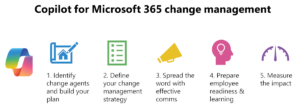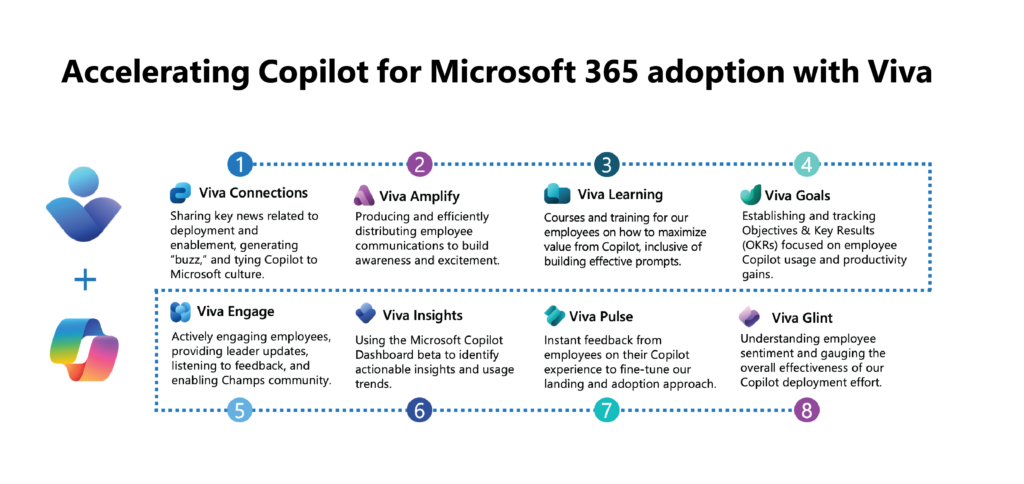![]() Generative AI has captured the world’s attention, and businesses are taking notice. According to Microsoft’s annual Work Trends report, 70% of people would delegate as much work as possible to AI to lessen their workloads (Microsoft, Work Trends Annual Report: Will AI Fix Work? 2023). Capitalizing on this trend will mean the difference between surging ahead or getting left behind, including here at Microsoft, where we’re the first enterprise to fully deploy Copilot for Microsoft 365.
Generative AI has captured the world’s attention, and businesses are taking notice. According to Microsoft’s annual Work Trends report, 70% of people would delegate as much work as possible to AI to lessen their workloads (Microsoft, Work Trends Annual Report: Will AI Fix Work? 2023). Capitalizing on this trend will mean the difference between surging ahead or getting left behind, including here at Microsoft, where we’re the first enterprise to fully deploy Copilot for Microsoft 365.

She would know—her team just finished deploying Copilot for Microsoft 365 to more than 300,000 employees and vendors across the world.
“The contents of this guide are based on the lessons we’ve learned deploying Copilot for Microsoft 365 at global enterprise scale. The tips and ideas you’ll read here will help you accelerate your own time to value so you can realize the same benefits as our employees.”
Our mission in Microsoft Digital is to empower, enable, and transform the company’s digital employee experience across devices, applications, and infrastructure. We also provide a blueprint for our customers to follow, and so have created this guide for deploying and adopting Copilot for Microsoft 365.

This executive summary of the complete Adoption and Deployment Guide is broken into four chapters designed to accelerate your time to value with Microsoft 365 Copilot:
Chapter 1: Getting governance right: Responsible AI depends on it
Before you even begin your Copilot for Microsoft 365 implementation, you’ll want to consider how this tool impacts your data. Copilot uses Large Language Models (LLMs) that interact with data and content across your organization and uses information your employees can access to transform user prompts into personalized, relevant, and actionable responses.
Giving your employees this level of access means proper data hygiene is a priority. At Microsoft Digital, we use sensitivity labeling to empower our employees with access while also protecting our data. Copilot for Microsoft 365 was designed to respect labels, permissions, and rights management service (RMS) protections that block content extraction on relevant file labels. That ensures private or confidential information stays that way.
Note: This chapter outlines the highly robust, best-case scenario we created for Microsoft, but we know not every organization has a fully deployed data governance strategy. If you’re in that position, don’t worry! You can use Restricted SharePoint Search to provide instant value and protection without exposing Copilot to all of your internal SharePoint sites.
Laying the groundwork with proper labeling
We’ve developed four data labeling practices that make up our foundation for appropriate policies and settings.
Enable your employees to create new workspaces like SharePoint sites, ensuring your company data is on your Microsoft 365 tenant. That enables your people to take full advantage of Copilot in ways that align with your organizational data hygiene while you keep your company’s information safe.
Label containers for data segmentation by default to ensure your information isn’t overexposed. At Microsoft, we default our container labels to “Confidential\Internal Only.” We use Microsoft Purview to manage this process.
Derive file labels from their parent containers. Consistency boosts security and reduces the administrative burden on your employees for labeling every file they create. Copilot will reflect file labels in chat responses so employees know the level of confidentiality of each portion of AI-created responses.
We train our employees to understand how to handle and label sensitive data. By making your employees active participants in your data hygiene strategy, you increase accuracy and improve your security posture.
Self-service with guardrails
The data hygiene practices above form a foundation for compliance and security but backstopping those efforts through Microsoft 365 features adds an extra layer of protection. Here’s how:
Empower self-service with sensitivity labels but verify by checking against data loss prevention standards, then use auto-labeling and quarantining when necessary. We’ve configured Microsoft Purview Data Loss Prevention to detect and control sensitive content automatically.
Put strong lifecycle management protocols in place that require your employees to attest containers to keep them from expiring. We don’t keep items that don’t have an accountable employee, or that might not be necessary for our work.
Limit oversharing at the source by enabling company-shareable links instead of forcing employees to grant access to large groups. To enforce these behaviors, you can set default link types based on labels through Purview.
Even under the best circumstances, accidents happen. When one of our employees does overshare sensitive data, we use Microsoft Graph Data Connect extraction in conjunction with Microsoft Purview to catch and report oversharing.
International compliance: No size fits all
Europe has extra requirements in the form of EU Data Boundary regulations and works councils, organizations that provide employee co-determination on workers’ rights or regulatory issues. Our Copilot for Microsoft 365 deployment meant we needed to partner closely with our Microsoft works councils to address complex data and privacy implications.
Your experience will vary depending on your industry and where you operate, but we’ve learned that it’s best to work closely with local subsidiaries to ensure you have a complete picture of a region’s regulatory situation. Local insiders are poised to liaise with works councils (here’s how we do so internally at Microsoft) or other bodies through direct relationships. Start the process early so you can manage feedback cycles effectively and resolve any concerns through configurations that work for your employees.
Learning from Microsoft’s governance, security, and compliance practices
Don’t keep this conversation in the IT sphere alone. Bring in all the relevant security, legal, and compliance professionals.
Microsoft Purview Data Loss Prevention has powerful intelligent detection, but it relies on establishing good defaults.
Determine the primary use cases. The kinds of collaboration and access employees need will affect your labeling architecture.
If you’ve been looking for an excuse to refresh employee knowledge around data privacy, let this moment be your milestone.
Make labeling easy and intuitive, and ensure it isn’t overwhelming.
Employees should have a limited set of choices to keep things simple.
Chapter 2: Implementation with intention
At the time of our deployment, we were the first company to do so at scale, and our implementation team had to choose from different licensing strategies. We’ve learned from experience that it makes sense to start with pilot groups who can validate the experience and enable the rest of your organization. At Microsoft, that looked like:
- Product engineers
- Sales
- Marketing
- Support
- HR
- Legal
- Security
- Works councils
- Advancing in phases, we deployed it to more than 300,000 Microsoft employees and external staff.
Scaling out your licenses
After you decide on the general shape of your rollout, you can begin building your licensing strategy. In Microsoft Digital, we started with individual licenses at the single-user level. As our implementation scaled, we tied licensing automation to Microsoft 365 groups to implement targeted licensing changes at scale. Those groups could include subsets of employees or entire organizations within Microsoft, and we keyed our automation logic to their expanding and contracting eligibility.
We highly recommend defining a phased rollout strategy and structuring your groups accordingly. That creates accountability and gives your IT admins a crucial point of contact for understanding the licensing needs of different groups within your organization.
There are three primary benefits to using groups:
![]() Optimize licensing costs
Optimize licensing costs
Create groups that reflect your business needs and goals that are aligned with your respective business sponsors. Sync your licensing status changes with your group membership changes. That way, you can assign the right licenses to the right users and adjust easily if you require frequent changes (e.g., in your early initial validation phase) and avoid paying for licenses you don’t need or use.
![]() Refine admin costs
Refine admin costs
Group-based licensing enables your admins to assign one or more product licenses to a group. This depends on your rollout strategy and progress—your admins will be able to streamline your group setup at scale, reducing your admin overhead, which is helpful considering all the licenses you likely need to manage.
![]() Enhance compliance and security
Enhance compliance and security
This ensures that only authorized users are licensed and have access to resources, enhancing your security and compliance. Your admins can use audit logs and other Microsoft Entra services to monitor and manage your group-based licensing activities.
Pre-adoption communications
Given the excitement around AI, one of the biggest challenges during our phased implementation was support requests from employees not within our initial pilot groups. Most of our support requests at this stage were essentially asking, “When do I get access?”
You can easily avoid the issue through clear and honest communication. For example, when you alert your initial implementation groups about their Copilot access, you could simultaneously deploy “Coming soon” emails to the rest of your organization. That will help you avoid any confusion while simultaneously generating excitement.
Your IT implementation team can’t work in isolation. Communication, especially with organizational leadership, is a key part of your licensing and implementation strategy.
Learning from Microsoft’s implementation
When you determine your initial cohorts, base your decisions on which roles have the largest coverage and will provide the most relevant feedback.
Be thoughtful about your Microsoft 365 groups and make sure everyone knows who owns them and who’s responsible.
This is a new technology, so your support teams will receive requests. Ensure they’re ready by giving them early access.
Proactively help users understand why they have licenses or don’t. Note that your rollout strategy might be subject to change.
Executive sponsorship isn’t just useful for adoption. Leaders will also help you identify the key use cases within their organizations.
Encourage feedback for employees in your early implementation phases because that will guide your wider adoption efforts.
Chapter 3: Driving adoption to accelerate value
The fact that your employees are excited about trying out Copilot isn’t enough. We found that you need strategic, coordinated change management to drive usage and adoption.
To do this effectively, you will need to empower change agents in your organization. These are not part time roles; they are dedicated resources across your company who are responsible for the change management function, including creation of a deployment and adoption plan, facilitating principled change management practices, communicating and engaging with employees, preparing employee readiness and learning opportunities, then measuring the success of your deployment across the enterprise. At a high level, your strategy should consist of the following five steps.

Focusing on change management is key when you deploy Copilot for Microsoft 365.
How Microsoft Digital drove adoption
At Microsoft, we broke our company-wide adoption efforts into cohorts, for example, subsidiaries or business groups. Depending on the size of your enterprise, you may benefit from this approach as well. We divided our adoption along two vectors: internal organizations like legal or sales and marketing, and regions like North America or Europe. Different cohorts have different focuses, but the strategy is similar. At Microsoft, we did this in four phases:
 Get ready
Get ready
Effective change management requires careful planning. Begin by identifying and then working with company-wide change management leads. Next, identify members of your target cohorts who will support the adoption, including change managers, leadership sponsors, and employee champions.
Champions will be crucial to your adoption by filling several powerful roles:
- Pinpointing key usage scenarios for Copilot based on their cohort’s culture or processes.
- Providing insights that help adoption leaders build out their rollout plans.
- Most importantly, demonstrating the value of Copilot and showing their peers how powerful this tool can be in their day-to-day work.
When champions socialize their tips and tricks, our experience at Microsoft Digital has revealed that it’s best to share specific prompts and the value they provided as a concrete entry point for users. For example, a champion could say, “I saved three hours drafting this sales script in Microsoft Word using this prompt,” then share their Copilot prompt as a place for peers to start.
Works councils also play a key role at this stage. They offer the benefit of local cultural expertise and can help you identify the challenges employees face in their jurisdiction. Even something as simple as understanding proper modes of address helps smooth the road to adoption through effective communication.
Each of these sets of stakeholders has a role to play in leading your own rollout. We recommend using Microsoft Copilot adoption resources to build out your own adoption plan.
 Onboard and engage
Onboard and engage
At Microsoft, we implemented this phase across each adoption cohort. Because every group will have its own champions and leadership sponsors, it’s important to treat each of them as its own organization, with its own unique adoption needs.
In advance of our general rollout, we created “jump-start” communications with links to learning opportunities:
- Localized training took the form of Power Hours in different languages and time zones. These training sessions demonstrated key Copilot scenarios across Microsoft 365 apps.
- Self-learn assets included user quick-start guides, demo videos, and Microsoft Viva Learning modules to accommodate different learning styles and preferences.
Pre-rollout communications fulfill two needs. First, this messaging is a great opportunity to launch your champion communities. Second, these communications build your employee population’s desire and excitement for their incoming Copilot licenses, then prepare them to hit the ground running when they get access.
After your Copilot licenses are live, your launch-day welcome comms are straightforward. Invite employees to access Copilot and to start experimenting with how it can fit into their work. There are many possible vectors for deploying these communications, but a multi-pronged effort that includes Microsoft Viva Amplify will deliver the maximum impact.
For support in building out your own communication plan, our adoption team has created a user onboarding kit for Copilot. These ready-to-send emails and community posts can help you onboard and engage your users.
 Deliver impact
Deliver impact
After everyone has access, it’s time to promote Copilot usage and ensure all employees are having the best possible experience and gaining the most value. For Microsoft’s cohorts, employee champions and leadership sponsors were essential levers.
It’s important to remember that Copilot isn’t just another tool. It introduces a whole new way of working within employees’ trusted apps. In Microsoft, we took great care to encourage employees to adapt a mindset to see it as part of their daily work—not just something they play with when there’s time.
Microsoft Viva Engage, or a similar employee communication platform, is a helpful forum for peer community support. In our case, it provided an organic space for champions to share their expertise and change managers to provide further recommendations and adoption content. For employees who explore best on their own, Copilot Lab provides in-the-flow learning opportunities to build their prompt skills.
Meanwhile, leadership sponsors diversified our communications strategy by deploying and amplifying messaging through executive channels like org-wide emails or Viva Engage Leadership Corner posts.
 Extend and optimize
Extend and optimize
Understanding overall usage patterns and impact is crucial to optimizing usage. Our Microsoft Digital team used a combination of controlled feature rollout (CFR) technology while tracking usage through Microsoft 365 Admin Center and the Copilot Dashboard in Viva Insights. Together, these tools gave us the visibility and tracking we needed to establish and communicate adoption patterns. Meanwhile, IT admins and user experience success managers can access simple in-app feedback through Microsoft 365 Admin Center. But to really maximize value, our Microsoft Digital employee experience teams conducted listening sessions and satisfaction surveys.
All these insights are helping us establish a virtuous cycle to drive further value and better adoption for future rollouts, extend usage to new and high-value scenarios, incorporate Copilot into business process transformation, and understand custom line-of-business opportunities.
Driving user enablement with Microsoft Viva
Microsoft Digital used Microsoft Viva to help enable our 300,000+ global users. Microsoft Viva is an Employee Experience Platform that brings together communication and feedback, analytics, goals, and learning in one unified solution. Microsoft Digital used Viva across a range of change management scenarios, including building awareness, communicating with our employees, providing access to readiness and learning resources, and measuring the impact of our deployment.
A few specific ways we used Viva to accelerate employee adoption are shown below.

We’re using Microsoft Viva to power employee adoption of Copilot for Microsoft 365 here at Microsoft.
Learning from Microsoft’s adoption efforts
Regional differences, priorities, even time zones can all block your centralization efforts. Your adoption leads in each cohort can help.
Monitor your user-led communities at the start. As this community of power users becomes product experts, they’ll take over.
You’ll be surprised by what your employees dream up. Provide every opportunity for them to share their favorite tips and usage scenarios.
Encourage a healthy mindset around what Copilot can accomplish and where it fits. Don’t overpromise.
Friendly competitions or cooperative challenges like prompt-a-thons generate excitement and invite creativity.
Overcome AI hesitancy by encouraging employees to tackle easy tasks with Copilot assistance. That will help minimize reluctance.
Viva supports user enablement through learning, effective
communication, usage tracking, and employee sentiment.
Chapter 4: Building a foundation for support
Empowering employees means making sure they have access to the right support channels. The fact that Copilot operates across a wide spectrum of Microsoft 365 apps adds complexity to support scenarios. As a result, it’s important to get your support teams early access along with your earliest pilot implementations. For Microsoft Digital, four principles define high-quality support:
Strategizing for support
Building experience and knowledge is one thing, but coming up with your approach to support requires planning and a strong idea of your users’ ideal experience. At Microsoft Digital, we take a “shift-left” approach. That means we save our human support staff time by attempting to create excellent self-service options for our users.
Shift-left principles can apply to many different support contexts, but with Copilot, we’ve found that the most important upfront action is ensuring your employees have accessible self-service support channels and communicating their availability. Work with your adoption teams to ensure they include self-service support options in their rollout communications.
Seven things we learned while preparing to support Copilot for Microsoft 365
Select your initial support specialists. Include people with different Microsoft 365 app focuses, support tiers, and service audiences.
Establish a community space where your support team can connect and collaborate on issues. Invite non-support professionals as needed.
Start a collaborative document and add learnings. This will eventually evolve into your knowledge base for internal support.
Host information sessions with the wider support team and extend access so all relevant support professionals can ramp up.
Conduct role-playing and shadowing sessions so support teams can build practical knowledge and confidence.
Get your support resources and processes ready and push them live in advance of your Copilot deployment. Consider a dry run.
Determine a tracking cadence and gather data on Copilot issues that arise so support teams can identify trending issues and tickets.
Common questions, issues, and resolutions
We’re getting questions about why particular employees don’t have licenses.
- Use employee change management communication waves to solve for this issue by alerting employees when they’ll have access to licenses.
Users are coming to us with questions that would be better served by adoption and employee material, and that isn’t our role as support.
- Work with your adoption team to preempt these issues with proactive communications. Update your self-help content and provide your support agents with ready access to different employee education resources.
Teams are looking for integration support. Where do I send them?
- Share this list of pre-built connectors to help your users integrate various data sources to Microsoft Graph. This list shares the types of content supported.
Can employees put confidential information into Copilot?
- If employees are signed into Copilot with their Entra ID, they can enter confidential information.
My organization has concerns about who owns the IP that Copilot generates. Does the Microsoft Customer Copyright Commitment apply to Copilot?
- Microsoft does not own the IP generated by Copilot. Our universal terms state “Microsoft does not own customers’ output content.”
What’s the best way to verify the accuracy of the information Copilot provides?
- Copilot is transparent about where it sources responses. It provides linked citations to these answers so the user can verify further.
Applying Microsoft’s lessons to your own Copilot deployment
Embarking on your Copilot for Microsoft 365 deployment journey might seem daunting, but by capitalizing on the lessons that Microsoft Digital has learned from Microsoft’s internal deployment, you can both speed up the process and avoid any pitfalls. By anchoring your work in careful planning and making use of the steps and resources provided in this guide, you can unleash a new era of productivity through Copilot.

You’re not in this alone. If you’re looking for support or knowledge on any aspect of your deployment, reach out to our customer success team.

Learn how to get ready for Copilot for Microsoft 365 at your company.

- Deploying Copilot for Microsoft 365 at Microsoft
- Getting the Most Out of Generative AI at Microsoft with Good Governance
- Access the Copilot scenario library to understand different user needs and opportunities.
- Gain insights from the Microsoft Copilot dashboard from Viva Insights
- Take part in user Enablement Strategy training or watch the session on demand.
- Copilot for Microsoft 365 technical readiness guide
- Copilot for Microsoft 365 training content map
- Copilot for Microsoft 365 user experience strategy document

Want more information? Email us and include a link to this story and we’ll get back to you.
Tags: Employee Experience, M365, Microsoft Copilot, Microsoft Viva








